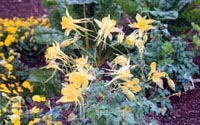Resource Library
Plant of the Week: Yellow Queen Columbine
The University of Arkansas System Division of Agriculture does not promote, support or recommend plants featured in "Plant of the Week." Please consult your local Extension office for plants suitable for your region.
Plant of the Week
Yellow Queen Columbine
Latin: Aquilegia chrysantha

Standing out from the crowd is important in Western culture. Each segment of society has its own unique way of recognizing standouts; the movie people give Oscars, the corporate world gives jillion dollar salaries; the sports world gives trophies while academicians give titles.
Programs to recognize Anew talent@ in the plant world have gained popularity during the last decade as the flood of new plant introductions swept across the land. The Arkansas Select program is our recognition program that highlights new and well-adapted plants for Arkansas gardeners. This year, five plants were selected as Arkansas Select winners. In this article, we’ll discuss one of these, yellow queen columbine (Aquilegia chrysantha or ‘yellow queen').
Yellow queen columbine is a spring blooming perennial that grows 24 inches tall and flowers from mid-April until mid-May. Yellow queen flowers are bright yellow and 2 inches across with five spectacular 2-inch long spurs sticking out behind the flower like the tail of a comet. The flowers are produced above the foliage and face forward, not looking at the ground as so often happens with columbines.
Like all columbines, it begins growth in late winter and produces the glaucous gray-green, much dissected leaves typical of the species. Plants form a stout crown and have a spread of about 1 foot. The flowering scape tends to branch freely producing a large number of flowers on well-established plants.
Aquilegia chrysantha is an indigenous species found in the southern Rocky Mountains in
New Mexico, Arizona and adjacent areas of Mexico. Yellow queen is but one selection from the species; most columbines from this species have good heat tolerance and are well adapted to our southern gardens. Not every garden center will carry yellow queen columbine, but most will offer seedlings of the species or hybrids, which have this plant as one of the parents. Seeds are available from mail order nurseries.
The selection of plants to receive Arkansas Select designation is a collaborative effort between members of the Arkansas Green Industry Association and the University of Arkansas Cooperative Extension Service and Department of Horticulture employees. The committee making the selections try to identify plants that are relatively new but have been grown enough to have confidence they will perform well across Arkansas. Yellow queen was nominated by a central Arkansas perennial grower who has grown it for several years and had good reports on its performance from his customers.
Yellow queen is a columbine, and like all members of that group, individual plants do not have long lives in the garden. Individual plants typically live three to five years and then die, but they will have produced seedlings, which migrate through the garden and come up in surprising places.
Columbines do best in light shade in well-drained soils. While they respond well to highly fertile site, individual plants may persist a bit longer in soils with moderate fertility. They don't need a lot of attention to watering, but watering during prolonged drought periods will keep the plants healthy and happy.
Columbine leaf miner is an insect, which occasionally infests leaves of all columbines, including yellow queen. This insect lays its eggs on the leaves around the time the plants start flowering. The resultant larvae tunnel through the leaves and cause serpentine trails and mar the beauty of the plant. The most practical control is to pick off affected leaves as early as possible and discard them in the trash, thus preventing the larvae from completing its life cycle.
By: Gerald Klingaman, retired
Extension Horticulturist - Ornamentals
Extension News - May 3, 2002
The University of Arkansas System Division of Agriculture does not maintain lists of retail outlets where these plants can be purchased. Please check your local nursery or other retail outlets to ask about the availability of these plants for your growing area.